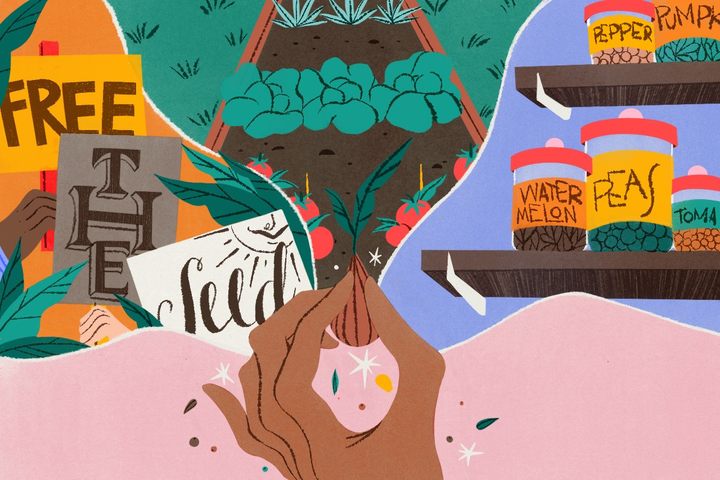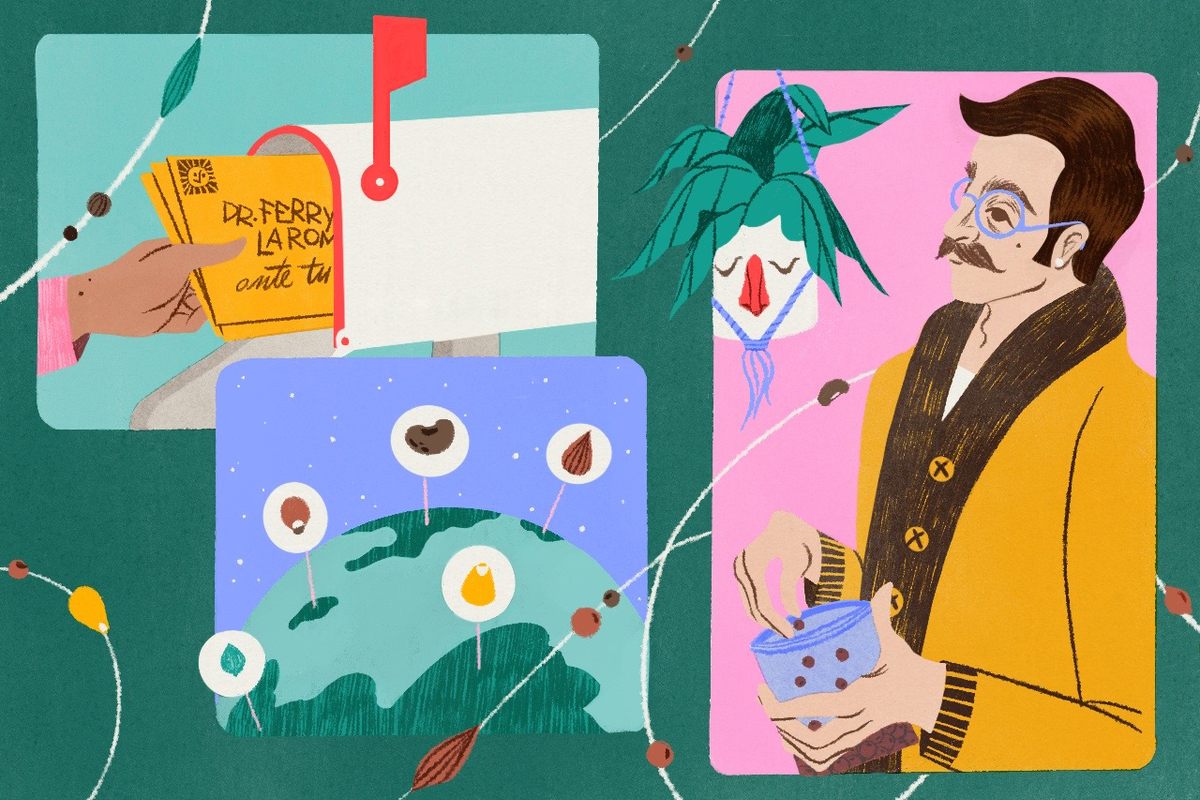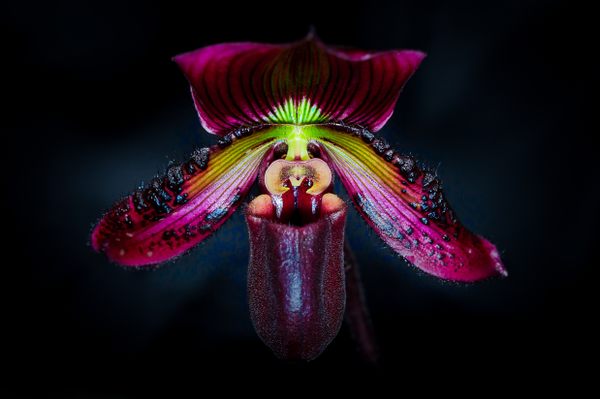

How to Plant a Home Garden and ‘Free the Seed’
By saving and swapping seeds, you can preserve agricultural heritage.
Of all the wonders in this wide world, there is none quite like the seed. With time, sun, and a little luck, a brown speck that fits on your fingernail can grow into a vast sequoia. Last year’s spit picnic seeds can become this year’s watermelon patch. And flecks from a few potato flowers can feed a nation.
It begins tentatively: A root stretches into soil, a sprout reaches toward the sun. Yet contained within each garden seed is a living record of the long-gone farmers who, over thousands of years, nursed bitter wild leaves and toxic forest fruits into the greens, beans, and grains that sustain us today. With each crop, these farmers chose the tastiest, highest-yielding plants, saved the seeds, and passed those tiny pieces of magic down to their children, eventually creating the cultivars we now know.
“Just a couple of generations ago, everybody was a seed saver,” says Ben Cohen, a farmer and founder of the Michigan Seed Library Network and Central Michigan Seed Swap. “You had to be a seed saver to grow your own food.”
Cohen started saving seeds, and swapping them with other farmers, eight years ago, when his family founded Small House Farms in rural Michigan. At first, seed saving was an economic necessity. “It was easier to save seeds than to purchase them every year,” he says. But what started in convenience quickly became a calling, as Cohen joined a vibrant community of seed savers, swappers, and growers dedicated to “freeing the seed.”
Cohen’s seed swap is just one part of a global movement. Since Congress passed the Plant Patent Act in 1930, agricultural companies have increasingly patented and profited from seeds. Many of these government and corporate research efforts have focused on increasing food production through standardized, high-yield crops, such as wheat, rice, and corn, and through the use of chemical fertilizers and pesticides. In the 1960s and ’70s, agricultural companies, international organizations, and national governments adapted these methods in many countries in the Global South, resulting in a “Green Revolution” that massively expanded agricultural output. Businesses that invested in this agricultural research often patented their seeds, claiming that the revenue helped sustain innovation.
Yet farmers and activists, particularly those from indigenous communities worldwide, have pushed back against the environmental and cultural impact of this agricultural system. Water-intensive crops like wheat and rice have displaced more traditional crops, parching the land and resulting in less nutrient-dense diets. Meanwhile, intellectual property laws force many farmers to purchase new seeds every year, an economic strain widely associated with increased farmer suicides in India. Many indigenous groups have also protested against non-indigenous companies patenting, and profiting from, their agricultural knowledge and traditions.
In response, a movement of growers has come together over the principle that seeds are a shared human heritage, not a private commodity. From the halls of the UN to the community garden down the block, advocates are working to free the seed by growing, sharing, and promoting the use of open-source, or non-patented, cultivars. And if you have a stocked pantry, some potting soil, and a backyard or even a sunny windowsill, you can join them—and enjoy low-cost, delicious produce. Here’s a simple guide.

Cultivate a Growth Mindset
Seed saving isn’t just a way of gardening. It’s a way of looking at life—or more specifically, a way of looking for life in unexpected places.
For Cohen, industrial food systems separate us from the reality that everything we eat comes from, and connects us with, other living things. In contrast, seed saving is about considering the origins of everything you eat. “When you become a seed saver, when you become interested in your food, you start to realize that your food is a living creature,” Cohen says. “It’s not a commodity, it’s not just something to take for granted.”
You also start to realize that humans are in a long-term relationship with plants. We have played a key role in plant domestication and evolution, just as the plants we have grown and harvested have helped shape our bodies and cultures. “A lot of the crops we grow can’t survive in the wild. They’re dependent on us, just as we’re dependent on them,” says Cohen.
Cohen suggests beginning by incorporating seed saving into your everyday culinary life. Notice the plants and plant parts you use to prepare meals. Where are the seeds? Where are the roots? Are parts of the produce still alive and growing? Notice that each seemingly pesky growth on cupboard potatoes could become a new potato plant. Same thing with the green stalk on an onion at the bottom of the bag.
Search for Open-Source Seeds
Not all seeds are equally suitable for saving. Much of the produce you find in the grocery store comes from hybrid crops, the result of genetic crosses whose seeds do not necessarily produce plants that are “true to type,” or identical to the parent plant. These seeds can be planted as an experiment, but you can’t be sure whether they will express the same traits as their parents.
Your best bet for consistent results is to choose seeds that are open-pollinated, meaning they aren’t hybridized and will thus be true to type. You can save seeds from an open-pollinated plant year after year, knowing that the offspring will have similar characteristics to the parent. Heirloom produce, which you’ve likely seen in your farmer’s market or referenced in articles on Gastro Obscura, is the result of open-pollinated seeds that have been saved and passed down, typically for 50 years or more.
Nonprofit organizations like the Open Source Seed Initiative (OSSI) promote the development of open-pollinated, non-patented seeds as public patrimony. When shopping for seeds, you can look for the OSSI label to be sure your seeds are open-pollinated.
Discover the Hidden Garden in Your Grocery Store
While grocery-store seeds are often hybrids, and thus less suited to saving than heirloom plants, your local supermarket is full of seed-saving opportunities, if you know where to look. If you ever sprouted a chickpea in a plastic bag as a grade-school science experiment, you’re already familiar with one common source of seeds.
Cohen suggests looking in the bulk aisle for dried beans or cowpeas. You can take them home and plant them directly in moist soil on a sunny windowsill. Or, you can try a “germination test” by putting them in a moist paper towel in a plastic ziploc bag, leaving the makeshift greenhouse somewhere warm, like the top of the fridge or a steamy bathroom shelf. Check them every few days for roots and then transfer the little seedlings to soil.
Tubers and root vegetables, including potatoes, onions, and garlic, are prime candidates for supermarket gardening, though technically you’re propagating the plant, rather than saving the seed. Simply cut a potato that has started to sprout into pieces with a few eyes or sprouts per piece, and plant each piece in a little soil on a sunny windowsill or backyard bed. Keep the soil moist, though not saturated, and you’re likely to have a spindly little potato plant in a week or two. You can similarly plant sprouting garlic and onions.
Some fruits, such as peppers, melons, and squash, are also good candidates for grocery-store seed saving. Cohen advises making sure the fruits fully ripen—let green peppers turn red, and melons turn fragrant—before saving their seeds. When the fruits are ripe, take out the seeds, wash all the pulp and sugar from them, and leave them to dry on a screen or paper plate for a week to 10 days. Storing them dry helps prevent the seeds from molding, allowing them to stay viable for a few years. Other seeds, including tomato seeds, benefit from being fermented before dry storage.
Connect to Local Land
Like seeds, the land we live on bears a story. If you live in the United States, the land you live and garden on is the heritage—largely stolen by European settlers—of Native American tribes. Many of our most beloved produce, such as corn and squash, are indigenous American crops. By learning about indigenous land and the agricultural heritage of your area, you can help preserve local cultivars and give due credit to the communities who created and continue to care for them.
“Local food comes from local seeds,” says Cohen. “To have a local-food movement, we need to have a local-seed movement.” You can search for regional, indigenous-led seed banks to learn more about the agricultural heritage of your area, and you can find online exchanges and companies specifically focused on native plants. Because native plants are adapted to your specific area, they often require less watering and greenhouse-gas-emitting chemical fertilizers, making them a more environmentally sustainable option as well.
Your neighborhood farmer’s market is also a great place to search for local seeds. The produce will be adapted to your region, and you can ask the grower about their offerings and how to best care for plants. “They might even have some extra seeds they’d be willing to share,” Cohen says.

Become a Backyard Scientist
Most of us learn about Friar Gregor Mendel, and his famous garden, in middle-school science class. By crossing pea plants and noting how they changed over generations, Mendel established the field of modern genetics. As a seed saver, you’re a modern-day Mendel engaged in a genetic experiment to find, plant, and save the seeds best suited to your garden and palate.
As plants mature, they either self-pollinate, meaning the plant itself has both the “male” and “female” parts required to produce fruits, or are pollinated by the wind or helpful insects. The resulting flower or fruit contains the seed.
Seed saving is simply harvesting the seeds from plants, drying them, and tucking them away for next year’s garden. For plants with edible fruits, such as tomatoes and peppers, this means extracting, rinsing, and drying the seeds from the ripe fruits. For plants like lettuce, whose edible part is the leaf, this involves letting the plant flower, and then waiting as these flowers go to seed. Depending on the plant, you’ll see the seeds emerge from the dried bud in the form of a pod or granules. Once the seeds dry on the plant, you can separate the seeds from the other plant material and store them in a cool, dry place.
By choosing the plants whose seeds you want to save, you’re selecting favorable traits—an extra sweet pepper, or a hefty watermelon—just like our early agricultural ancestors. “Seed savers in essence are plant breeders,” says Cohen. “When you select these plants, those are the traits that our gardens give back to us.” Over time, the seeds will become adapted to your particular garden (or windowsill), and after years of careful selection, you can even develop a new variety of your favorite food.
Share Stories at a Seed Swap
Nothing embodies the spirit of seed saving more than a good ol’ fashioned swap. Cohen organized his first seed swap five years ago, after a trip to a nearby living-history farm left him with more Cherokee black bean seeds than he knew what to do with.
The first year, 100 people showed up. “We realized we’d tapped into a need in the community,” he says. The gathering has only grown, and now “it’s like a family reunion.”
Swaps mean more than just seeds. They represent the stories that come with each cultivar, a living memory of gardeners, cooks, and loved ones that expands with each season. Over the years, Cohen has watched those original Cherokee black beans, and the community that saves them, multiply. “A handful of beans became hundreds of beans. A handful of seed savers became hundreds of seed savers,” Cohen says. Other sources of community seeds include seed libraries, which “lend” locals seeds with the expectation that gardeners will save and bring back seeds from their crops.
You can find local seed swaps and seed libraries through this directory, your local gardening club or library, or through social media. You can also organize a seed swap of your own—though, of course, during the COVID-19 pandemic, you should avoid gathering with others until public-health officials give the green light. Finally, especially during these times of social distancing, you can join online seed-swapping communities, and share seeds and stories through the mail, or do contactless seed drop-offs with neighbors.
“It may seem intimidating at first, like any new thing you’ve ever tried,” says Cohen. But people have been saving and swapping seeds for thousands of years. It’s a folk tradition, a tradition of everyday people, and that means it’s your tradition, too. “It’s inside all of us,” Cohen says. So start slow, pick a few seeds, learn from a few neighbors, and watch as your plants—and your communities—thrive.
You can find a free guide to saving different types of seeds at Seed Savers Exchange, or you can order Ben Cohen’s seed-saving book.
Gastro Obscura covers the world’s most wondrous food and drink.
Sign up for our regular newsletter.























Follow us on Twitter to get the latest on the world's hidden wonders.
Like us on Facebook to get the latest on the world's hidden wonders.
Follow us on Twitter Like us on Facebook